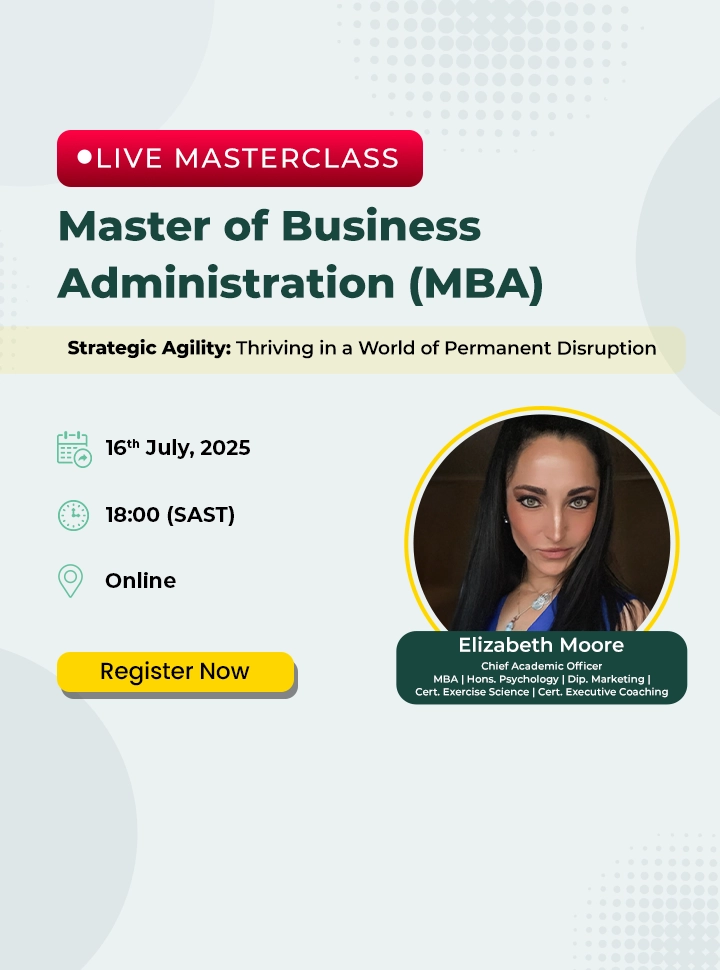Regenesys Business School recently held an Executive Education webinar on Digital Transformation in Times of Crisis.
Disruption has forced executive development specialists to rethink and reimagine executive and management development. Neuroscience has helped us understand how people learn. The challenge now is how to incorporate this into digital approaches and practical learning. Our panel of distinguished executive education experts from leading global and local organisations shared their experiences in this dynamic and fast-changing field.
The key learnings and insights of this sell-out event are summarised below.
Strategy

- Digital transformation goes right to the heart of the business. In a sense, everything can change and is changing.
- A comprehensive corporate digital learning strategy is an essential component. It must be supported by executives and line managers and draw organisation-wide collaboration
- The time is now to make a complete shift, to capitalise on what had been learned and to address their gaps and weaknesses in training and management delivery systems.
- The Covid Crisis is also the opportunity to create big learning interventions. As organisations are reeling from the new challenges, the window for change opens and many organisational initiatives can be bundled with the response to the Covid Crisis.
- The Covid Crisis presents a marvellous window of opportunity to drive digital development and transformation within organisations. It becomes a key motivator for making the necessary changes and implementing the necessary actions so that the organisation does not slip back to its pre-Covid days.
- Much maturity is need on the digital transformation path. Go too slow and you fall behind. Go to fast and you leave the organisation behind. The organisation’s purpose finds effect in the business strategy and the continual dance between competitors and customers has to set the pace of change.
Content

- Content curation is going to take over from content creation.
- Here is a segue on content curation as a way to support customised content creation. Content creation is the creation of content from scratch, and presenting it to the learner as a course. Content curation, on the other hand, is the process of gathering relevant existing information like blogs, social media posts, websites, videos and e-books, filtering them for the most relevant pieces and making them available to learners. Learners then choose the most suitable content and create their own learning experience. We are going to have to get much better at this as digital transformation progresses.
- 42 Silicon Valley was put forward as an example of an online digital just in time learning facility. 42 is an innovative engineering and programming college offering rigorous, industry-leading education in a professional environment. Their website speaks of zero tuition, zero teachers, zero classes and 100% coding.
The 42 programme is designed to prepare students for the workplace using an instructional design where students learn skills for the digital world. Projects range from 48 hours to 6 months, depending on their depth and complexity. Projects are corrected by peers, and students learn technical skills as well as interpersonal skills, time management, and project management. Each student advances at their own pace. The educational curriculum is 100% individualised.
The 42 approach chimes with the modern training mantra of “learn what you need to learn when you need to learn it”. The corporate trainer is now more like a librarian, curating a range of suitable training offerings via different media, rather than being a subject matter expert. The corporate trainer now becomes more of a researcher and complier, and less of the technical expert.
- There are many alternatives to the standard training course package. People learn from peers, mentors, experience or books. The use of technology changes how we use these resources.
Technology

- Online training was revolutionised. In the past 80% was classroom-based and 20% was online – for organisations with online training capability. With the Covid Crisis, it all had to go online. People had to learn how to learn in the new context.
- For many people, the transformed work from home [WFH] regime is highly attractive for certain categories of workers. It holds many advantages. Less office space is required, no commuting time is wasted, except for in-office meetings, and a work-life/home life balance can be maintained. Managers will have to get used to managing in these contexts, and adapt new responses to performance management.
- Organisations should be wary of the temptation of “platformification”. The organisation is embarking on a journey of transformation. Culture, leadership and strategy should be the key determinants. The technology and the platforms are merely a means to consolidate the culture, to support leadership and to achieve the strategy. There is a need to align the human development requirements with what is happening globally, in South Africa and in the organisation, so that the organisation is not out of step with the big picture.
- Virtual reality tools have great application in shop floor training. Learners can experience the working situation without being exposed to the dangers and stoppages of a production line. It has also seen good application in occupational health and safety training. We are still in the infancy of the application of this technology – it holds great promise for the future.
People

- People needed help and assistance to get into and use online learning. Create the opportunities and resources for them to do so.
- The Covid Crisis has put the processes of recruitment and onboarding into stark perspective. More attention is required for online induction processes, and assisting new employees to get up to speed with “how things are done around here.”
- Non-connected employees must not be forgotten in this transformation journey. The ubiquity of mobile phones is an effective option. The pervasive use of WhatsApp chat groups is already well entrenched. As more and more organisations opt for hoteling use of office space, the opportunities for e-lab access by unconnected staff members becomes practical. [Hoteling is an office use approach where workers schedule their use of workspaces such as desks, cubicles, and offices. It is an alternative to traditional permanent workstations].
- In the midst of this crisis-driven digital transformation we must not lose our humanity. Space has to be made for coaching, for encouragement and opening conversations between team members. The danger of a hard tech approach is that we get lost in the applications and delivery and forget the essential human element.
- There is a special place for employee representatives in this digital transformation roller coaster ride. They provide an important reality check on what is practical. Further, they can provide valuable insights not only about how training is delivered, but also the content, so that learners can fully master the learning. Employee representative organisations help to ensure that there are appropriate career and learning paths and that employees have adequate opportunity for self-improvement.
- Training is required in the “soft stuff” as well as in technical and operational topics. Emotional intelligence has become an essential partnership skill in digital transformation, and enlightened organisations are building a repertoire of offerings in the discipline. In all the noise of digital and automation, emotional intelligence remains unassailed as a critical human competency. Soft skill training helps to evolve a corporate vocabulary, it becomes part of the institutional way of communicating and solving problems. It becomes a tangible part of corporate culture. Similar requirements exist for conflict management, empathy, critical thinking, leadership, and resilience.
Learning

- There has been a re-look at how employees best learn. Flexible content, self-driven discovery, and learner-driven learning approaches have come to the fore. This, in turn, requires sensible and appropriate investment in supportive and integrated digital learning platforms.
- Microlearning has become a valuable training approach. While not suitable for in depth-training, it is an effective adjunct to other modes. Microlearning is a short, focused learning component, often 3-5 mins long or shorter, designed to meet a specific learning outcome. It works particularly well in informal training as part of a content curation strategy.
- Training design should follow a journey approach. Rather than have individual, isolated chunks of training content, the individual components should network together to take the learner down a path of structured learning and career growth. Developmental experiences and training should integrate within job families. With healthy competitive collaboration, new industry norms can be established, driving better quality and increasing value.
- When adjusting to the sort of digital transformation we are experiencing, it is helpful to use the following three headings:
- Purpose: What is the purpose of the changes, what is the end goal it supports, does the executive team understand this and their roles in it? Is the executive team cascading this understanding down through their teams?
- Potential: We have to find new ways to integrate human systems and technological systems to enable the organisation to construct new understanding about what the organisation can achieve. Doing what we have always done, but on a digital platform, is not sufficient. We can use this transformation opportunity to springboard into the future.
- Perspective: As we move further into transformed digital education, we have to take account of the realities of inadequate Wi-Fi access. This is going to temper our expectations as we proceed. This has significant impact on remote working. We also have to make better use of our existing content. Furthermore, we will have to seek out and curate suitable content from other sources. We do not have the luxury of time and resources to develop our own.
- The delivery of training has to undergo transition as well. The talking heads and static slide deck approach no longer is efficient. Leaners want interaction, the energy needs to shift from the trainer to the trainee. Leaners want to grasp, inquire, question, and reflect, so that learning becomes sticky, They want to drive their learning experience to meet their personal and career aspirations.
- Just in time training has become the norm. Learners, and their managers, don’t want to wait weeks for the next scheduled course. They want the training now, and the workplace application to take place concurrently with it or immediately afterwards. This is where content curation becomes doubly important. Fortunately, we have access to all of the power of MOOCs from top institutions, YouTube videos by leaders in their field as well as other sources. Collaboration between these specialists is an essential part of high-quality just in time training. Business skills training will require relationships with universities with the necessary expertise wherever in the world they happen to be. Organisations with training programmes that do not compromise proprietary intellectual property are able to share and barter programmes with other organisations in the same industry, around the world.
Self-development
- As digital transformation drives to maturity, there is a need to address important collateral issues. Communication will require much more structured attention when the body language cues of remote team members cannot be read. The interaction between employees will require special consideration. When some team members are no longer in face to face meetings, alternative ways of maintaining the social interfaces will have to be explored. Emotional support is a matter not to be overlooked. And different approaches to granting recognition to staff will have to be considered. Hard coding change management capability into the organisation becomes easier in the sense that the traditional ground rules have changed.
Smarts

- It is important to keep up with trends in digital technology and EdTech. Subscribe to websites and authorities who are leaders in your area of need. Use tools like Google Alert to regularly bring information top you.
- The Covid Crisis has a silver lining. It has accelerated the move to online learning and online working. The wholesale adoption of digital communication and work tools. We have been forced into this. The transition was messy at first, but human ingenuity and agility came up with solutions. People had to use what they had and adapt in innovative ways to the situation.
- The Covid Crisis was a great leveller. In many senses, it became OK to make mistakes because we were all learning how to cope with a fully online organisation. This, in turn, was an opportunity to rethink old operating models how work is allocated managed and evaluated.
- The well-known Charles Darwin quote is particularly apposite here:
“It is not the strongest of the species that survives, nor the most intelligent; it is the one most adaptable to change.”
Success does not necessarily go to the organisations that have the most “stuff” but those who are most agile in their response – those that are most adaptable to change.
Takeaways from the conversation:
- Digital transformation is a reality, embrace it and take charge of your own learning.
- Develop a growth mindset within an agenda of lifelong learning.
- Neuroscience tells us of new ways of how the brain works and how new learning keeps the brain healthy.
- Jump in at the deep end. Arm yourself with personal resilience and emotional intelligence.
- The Covid Crisis is a window of opportunity, mark out your space in it.
- Be able to pivot, change direction, as things change, and new information appears. Be human.
Regenesys Business School thanks the panellists for their deep insights and generous sharing.
We also thank all of you who attended the webinar. Thanks for being part of the Regenesys Community.
Be sure to be on the lookout for our next fascinating webinar on a topic of current importance.
END
*Being the outcome of an online discussion on Leading Executive Education – Digital Transformation in Times of Crisis held on the 18th of August 2020.
The Panelists included:
- Lovinthrie Reddy, Head of Learning and Development, Old Mutual Insure
- Agreepa Neduvhuledza, Southern Africa Head, Operations & Performance Improvement, Enel Green Power
- Itumeleng Mosiane, Head of Learning and Development, FNB Business Bank
- Vanessa Kodisang, Head of Talent and Learning, Danone
- Neil Solomon, Head of Learning, ABSA
- Nomsa Lewisa, Group Technology and Digital Solutions Manager – Human Capital, Barloworld
- Liza Wilmot, Learning Academy Manager, Volkswagen Group
- Henry Karow, Head of Executive Development, Regenesys Business School (Facilitator)
Read also:







